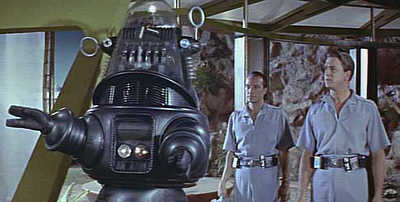"Monsters, monsters from the id!"
 While rummaging through movie classics recently, I ran across one of the greatest of science fiction films ever, Forbidden Planet. Released in 1956, it starred Leslie Nielsen as spaceship commander Adams, Walter Pidgeon as the mysterious Dr. Morbius*, and Anne Francis as his lovely, innocently wise daughter, Alta. Loosely based on Shakespeare's Tempest, no movie did more, in one stroke, to make science fiction a respectable genre.
While rummaging through movie classics recently, I ran across one of the greatest of science fiction films ever, Forbidden Planet. Released in 1956, it starred Leslie Nielsen as spaceship commander Adams, Walter Pidgeon as the mysterious Dr. Morbius*, and Anne Francis as his lovely, innocently wise daughter, Alta. Loosely based on Shakespeare's Tempest, no movie did more, in one stroke, to make science fiction a respectable genre.Today, Forbidden Planet seems somewhat awkward. The original trailer didn't quite know what to do: proclaim it just another B.E.M. ("bug-eyed monster") movie, or pitch it "highbrow"? But its innovations make up a long list copied in obvious ways by almost all later movie and television science fiction. Looking for the origin of the Star Trek transporters and warp drive, or the suspended animation of Lost in Space and 2001? Looking for the origin of the whole Star Trek paradigm -- an Earth ship encountering humans stranded on an alien world, humans needing but not wanting rescue; or the familiar trio of captain, executive officer, and doctor? Looking for the origins of a sophisticated visual science fiction with literary roots? The origin of Star Wars' charming, superhuman robots? The sinister potential of advanced technology? Far-out electronic "space" music for a score? Here it is.
 MGM knew what it was doing and spared no expense or care for detail. The production values were astonishing for the time. The robot later known as Robby was introduced by Forbidden Planet and would later make multiple movie and television appearances. Here he is an aloof but ever-helpful machine that (who?) can, from a small sample, make apparently endless supplies of anything desired. Reminiscent of his avatar Caliban, he is the remains of a race of superintelligent beings called the Krell, whose technology Morbius reconstructs and uses to enhance his own mind to superhuman levels. Glimpses of the Krell's technical achievements are thrown out to whet the audience's appetite. The only mystery is the why the Krell vanished.
MGM knew what it was doing and spared no expense or care for detail. The production values were astonishing for the time. The robot later known as Robby was introduced by Forbidden Planet and would later make multiple movie and television appearances. Here he is an aloof but ever-helpful machine that (who?) can, from a small sample, make apparently endless supplies of anything desired. Reminiscent of his avatar Caliban, he is the remains of a race of superintelligent beings called the Krell, whose technology Morbius reconstructs and uses to enhance his own mind to superhuman levels. Glimpses of the Krell's technical achievements are thrown out to whet the audience's appetite. The only mystery is the why the Krell vanished.The movie's most brilliant stroke is that the Krell and their likeness are never shown, only hinted at. Also never shown directly is the monster that kills several starship crew members and which is only glimpsed in one scene produced by some Disney personnel "lent" to MGM. A technique borrowed from horror flicks -- never showing the danger directly -- moves Forbidden Planet far beyond the staple sci-fi movies of the Fifties. The cinematography in Technicolor and the score entirely produced by electronics, not traditional instruments, reinforces these qualities.
The full force of the story doesn't kick you in the head until the last scene. Watching the detonation of the planet from far away, Anne Francis and Leslie Nielsen are left to contemplate the failure of a high civilization, the awesome Krell, whose technical mastery put them under the illusion that they had escaped their own animality.
POSTSCRIPT: The electronically-scored soundtrack is available on a separate CD, which was first released in 1986 for the film's thirtieth anniversary. A special two-disc DVD set was issued for the movie's fiftieth anniversary in 2006.
The score's creators, husband-and-wife team Louis and Bebe Barron, were not sure they were doing sound effects, or music -- until John Cage convinced them that it was music.
---
* An interesting merger of "morbid" and "Möbius," as in the non-orientable Möbius strip.
Labels: movies, music, popular culture









